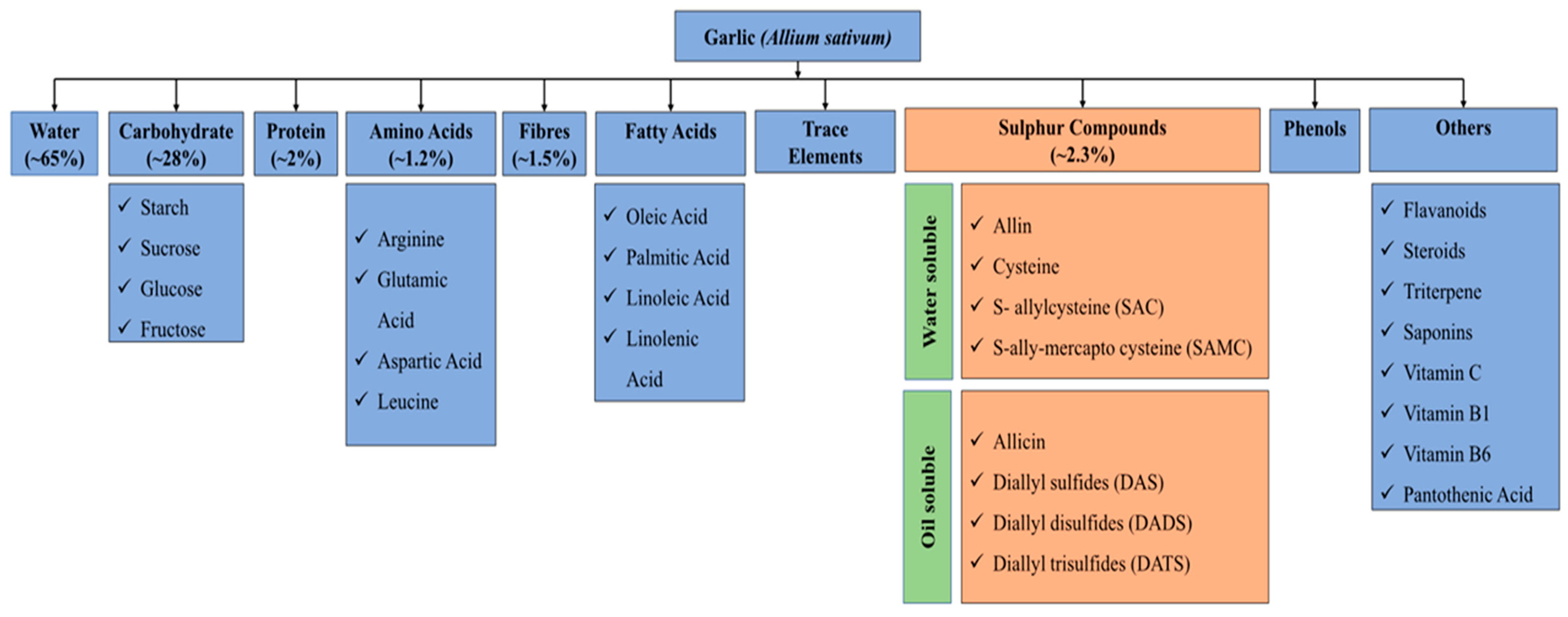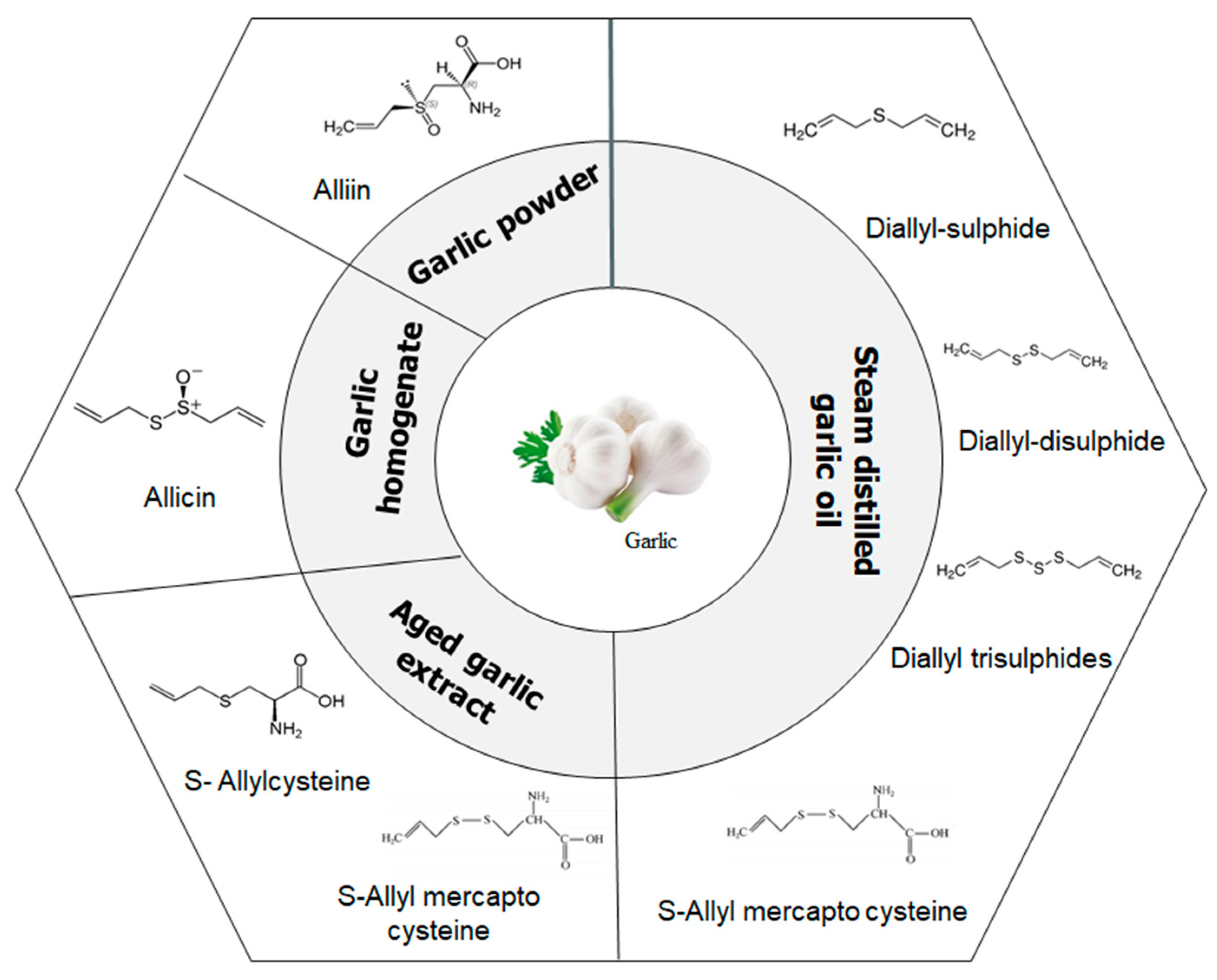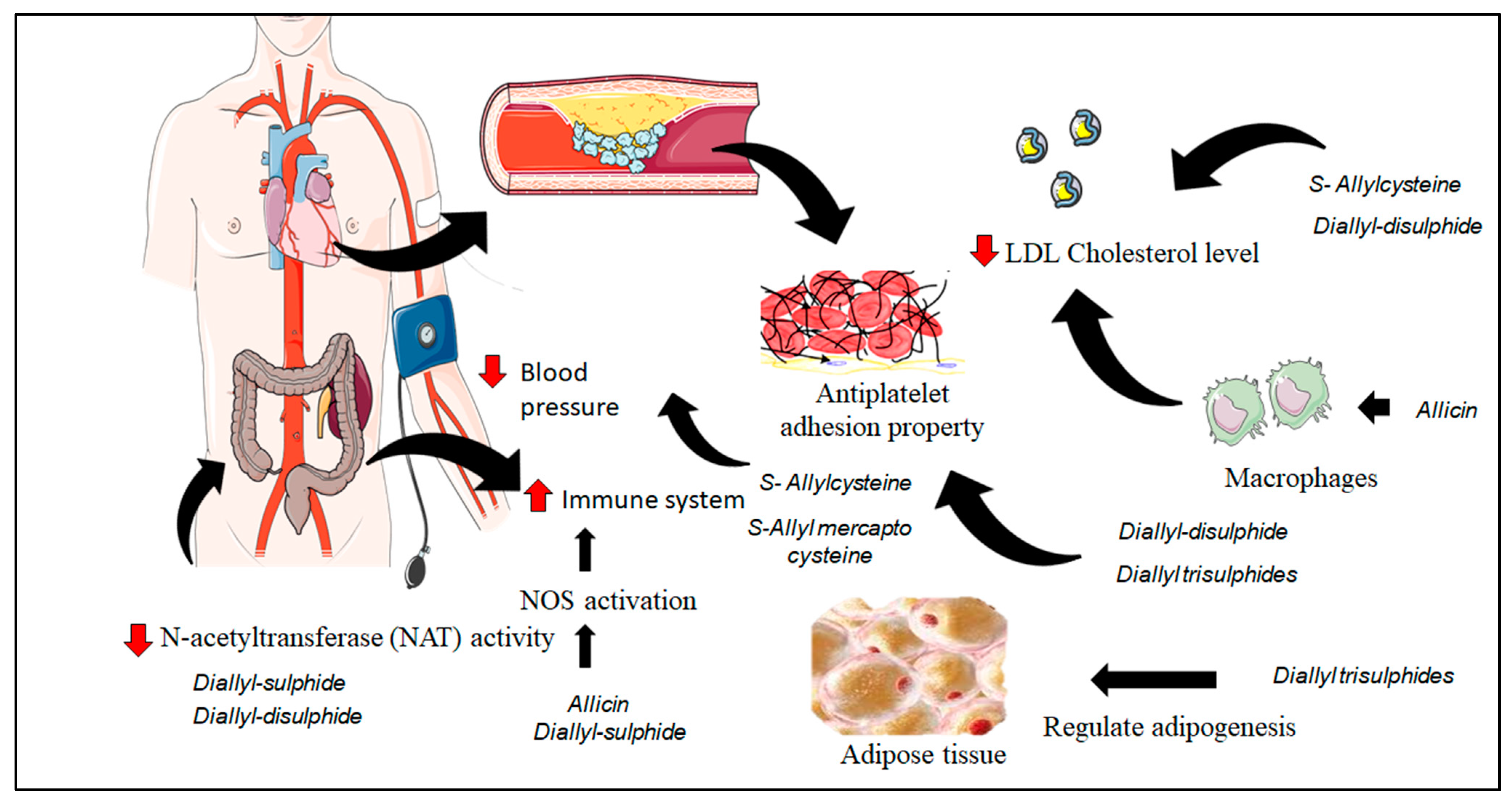Prevailing Knowledge on the Bioavailability and Biological Activities of Sulphur Compounds from Alliums: A Potential Drug Candidate
Abstract
1. Introduction
2. Types of Active Compounds
3. Sulphur Compounds
3.1. Water-Soluble Sulphur Compounds
3.1.1. Alliin
3.1.2. S-Allylcysteine (SAC)
3.1.3. S-Allyl Mercapto Cysteine (SAMC)
3.2. Oil-Soluble Sulphur Compounds
3.2.1. Allicin
3.2.2. Diallyl Sulphides (DAS)
3.2.3. Diallyl Disulphides (DADS)
3.2.4. Diallyl Trisulphides (DATS)
4. Garlic Oil, Powder and Its Biological Uses
5. Biological Activities of Sulfur Compounds from Allium sativum
5.1. Effects on Cardiovascular Diseases
5.2. Effects on Atherosclerosis and Lipid Metabolism
5.3. Effects on Hypertension
5.4. Effects on Platelets and Fibrinolytic Activity
5.5. Effects on Cancer
5.6. Effects on Immunomodulatory Response
5.7. Effects on Obesity
6. Conclusions
Author Contributions
Funding
Acknowledgments
Conflicts of Interest
References
- Banerjee, S.K.; Maulik, S.K. Effect of garlic on cardiovascular disorders: A review. Nutr. J. 2002, 1, 1–14. [Google Scholar] [CrossRef] [PubMed]
- Zahid Ashraf, M.; Hussain, M.E.; Fahim, M. Antiatherosclerotic effects of dietary supplementations of garlic and turmeric: Restoration of endothelial function in rats. Life Sci. 2005, 77, 837–857. [Google Scholar] [CrossRef] [PubMed]
- Chan, J.Y.Y.; Yuen, A.C.Y.; Chan, R.Y.K.; Chan, S.W. A review of the cardiovascular benefits and antioxidant properties of allicin. Phyther. Res. 2013, 27, 637–646. [Google Scholar] [CrossRef] [PubMed]
- Kearney, P.M.; Whelton, M.; Reynolds, K.; Muntner, P.; Whelton, P.K.; He, J. Global burden of hypertension: Analysis of worldwide data. Lancet 2005, 365, 217–223. [Google Scholar] [CrossRef]
- Gonen, A.; Harats, D.; Rabinkov, A.; Miron, T.; Mirelman, D.; Wilchek, M.; Weiner, L.; Ulman, E.; Levkovitz, H.; Ben-Shushan, D.; et al. The antiatherogenic effect of allicin: Possible mode of action. Pathobiology 2006, 72, 325–334. [Google Scholar] [CrossRef]
- Mag, P.; Bose, S.; Laha, B.; Banerjee, S. Quantification of allicin by high performance liquid chromatography ultraviolet analysis with effect of post ultrasonic sound and microwave radiation on fresh garlic cloves. Pharmacog. Mag. 2014, 10. [Google Scholar] [CrossRef]
- Kimura, S.; Tung, Y.C.; Pan, M.H.; Su, N.W.; Lai, Y.J.; Cheng, K.C. Black garlic: A critical review of its production, bioactivity, and application. J. Food Drug Anal. 2017, 25, 62–70. [Google Scholar] [CrossRef]
- Mikaili, P.; Maadirad, S.; Moloudizargari, M.; Aghajanshakeri, S.; Sarahroodi, S. Therapeutic uses and pharmacological properties of garlic, shallot, and their biologically active compounds. Iran J. Basic Med. Sci. 2013, 16, 1031–1048. [Google Scholar]
- Rose, P.; Moore, P.K.; Whiteman, M.; Zhu, Y.Z. An appraisal of developments in allium sulfur chemistry: Expanding the pharmacopeia of garlic. Molecules 2019, 24, 4006. [Google Scholar] [CrossRef]
- Fukushima, S.; Takada, N.; Wanibuchi, H.; Hori, T.; Min, W.; Ogawa, M. Recent advances on the nutritional effects associated with the use of garlic as a supplement suppression of chemical carcinogenesis by water-soluble organosulfur. J. Nutr. 2001, 1049–1053. [Google Scholar] [CrossRef]
- Chobanian, A.V.; Bakris, G.L.; Black, H.R.; Cushman, W.C.; Green, L.A.; Izzo, J.L.; Jones, D.W.; Materson, B.J.; Oparil, S.; Wright, J.T.; et al. Seventh report of the Joint National Committee on prevention, detection, evaluation, and treatment of high blood pressure. Hypertension 2003, 42, 1206–1252. [Google Scholar] [CrossRef] [PubMed]
- Kumar, K.P.S.; Bhowmik, D.; Chiranjib; Tiwari, P.; Khare, R. Allium sativum and its health benefits: An overview. J. Chem. Pharm. Res. 2010, 2, 135–146. [Google Scholar]
- Bhandari, P.R. Garlic (Allium sativum L.): A review of potential therapeutic applications. Int. J. Green Pharm. 2012, 6, 118. [Google Scholar] [CrossRef]
- Lawson, L.D.; Wang, Z.J. Allicin and allicin-derived garlic compounds increase breath acetone through allyl methyl sulfide: Use in measuring allicin bioavailability. J. Agric. Food Chem. 2005, 53, 1974–1983. [Google Scholar] [CrossRef] [PubMed]
- Batiha, G.E.; Beshbishy, A.M.; Wasef, L.G. Chemical constituents and pharmacological activities of garlic (Allium sativum L.): A Review. Nutrients 2020, 12, 872. [Google Scholar] [CrossRef] [PubMed]
- Zhang, Y.; Liu, X.; Ruan, J.; Zhuang, X.; Zhang, X.; Li, Z. Phytochemicals of garlic: Promising candidates for cancer therapy. Biomed. Pharmacother. 2020, 123, 109730. [Google Scholar] [CrossRef]
- Londhe, V.P.; Gavasane, A.T.; Nipate, S.S.; Bandawane, D.D.; Chaudhari, P.D. Role of garlic (Allium sativum) in various diseases: An overview. J. Pharma.Res. 2011, 1, 129–134. [Google Scholar]
- Bordia, A.; Verma, S.K.; Srivastava, K.C. Effect of garlic (Allium sativum) on blood lipids, blood sugar, fibrinogen and fibrinolytic activity in patients with coronary artery disease. Prostaglandins Leukot Essent Fatty Acids. 1998, 58, 257–263. [Google Scholar] [CrossRef]
- Kim, K.M.; Chun, S.B.; Koo, M.S.; Choi, W.J.; Kim, T.W.; Kwon, Y.G.; Chung, H.T.; Billiar, T.R.; Kim, Y.M. Differential regulation of NO availability from macrophages and endothelial cells by the garlic component S-allyl cysteine. Free Radic. Biol. Med. 2001, 30, 747–756. [Google Scholar] [CrossRef]
- Welch, C.; Wuarin, L.; Side, N. Antiproliferative effect of the garlic compound on human neuroblastoma cells in vitro S-ally1 cysteine. Cancer Lett. 1992, 63, 211–219. [Google Scholar] [CrossRef]
- Ashafaq, M.; Khan, M.M.; Shadab Raza, S.; Ahmad, A.; Khuwaja, G.; Javed, H.; Khan, A.; Islam, F.; Siddiqui, M.S.; Safhi, M.M.; et al. S-allyl cysteine mitigates oxidative damage and improves neurologic deficit in a rat model of focal cerebral ischemia. Nutr. Res. 2012, 32, 133–143. [Google Scholar] [CrossRef] [PubMed]
- Saravanan, G.; Ponmurugan, P. Beneficial effect of S-allylcysteine (SAC) on blood glucose and pancreatic antioxidant system in streptozotocin diabetic rats. Plant Foods Hum. Nutr. 2010, 65, 374–378. [Google Scholar] [CrossRef] [PubMed]
- Ng, K.T.P.; Guo, D.Y.; Cheng, Q.; Geng, W.; Ling, C.C.; Li, C.X.; Liu, X.B.; Ma, Y.Y.; Lo, C.M.; Poon, R.T.P.; et al. A garlic derivative, s-allylcysteine (sac), suppresses proliferation and metastasis of hepatocellular carcinoma. PLoS ONE 2012, 7, e31655. [Google Scholar] [CrossRef] [PubMed]
- Numagami, Y.; Ohnishi, S.T. S-Allylcysteine Inhibits Free Radical Production, Lipid Peroxidation and Neuronal Damage in Rat Brain Ischemia. Molecules 2001, 131, 1100S–1105S. [Google Scholar] [CrossRef] [PubMed]
- Shirin, H.; Pinto, J.T.; Kawabata, Y.; Soh, J.; Delohery, T.; Moss, S.F.; Murty, V.; Rivlin, R.S.; Holt, P.R.; Weinstein, I.B. Antiproliferative effects of S-allylmercaptocysteine on colon cancer cells when tested alone or in combination with sulindac sulfide. Cancer Res. 2001, 61, 725–731. [Google Scholar]
- Sigounas, G.; Hooker, J.L.; Li, W.; Anagnostou, A.; Sigounas, G.; Hooker, J.L.; Li, W.; Anagnostou, A.; Steiner, M. S-Allylmercaptocysteine, a stable thioallyl compound, induces apoptosis in erythroleukemia cell lines. Nutr. Cancer 2009, 37–41. [Google Scholar] [CrossRef]
- Sumioka, I.; Matsura, T.; Yamada, K. Therapeutic effect of S-allylmercaptocysteine on acetaminophen-induced liver injury in mice. Eur. J. Pharmacol. 2001, 433, 177–185. [Google Scholar] [CrossRef]
- Cha, J.H.; Choi, Y.J.; Cha, S.H.; Choi, C.H.; Cho, W.H. Allicin inhibits cell growth and induces apoptosis in U87MG human glioblastoma cells through an ERK-dependent pathway. Oncol. Rep. 2012, 28, 41–48. [Google Scholar] [CrossRef]
- Chu, Y.L.; Ho, C.T.; Chung, J.G.; Rajasekaran, R.; Sheen, L.Y. Allicin induces p53-mediated autophagy in Hep G2 human liver cancer cells. J. Agric. Food Chem. 2012, 60, 8363–8371. [Google Scholar] [CrossRef]
- Younis, F.; Mirelman, D.; Rabinkov, A.; Rosenthal, T. S-allyl-mercapto-captopril: A novel compound in the treatment of cohen-rosenthal diabetic hypertensive rats. J. Clin. Hypertens. 2010, 12, 451–455. [Google Scholar] [CrossRef]
- Murillo, G.; Mehta, R.G. Chemoprevention of chemically-induced mammary and colon carcinogenesis by 1alpha-hydroxyvitamin D5. Steroid Biochem. Mol. Biol. 2005, 97, 129–136. [Google Scholar] [CrossRef] [PubMed]
- Altonsy, M.O.; Andrews, S.C. Diallyl disulphide, a beneficial component of garlic oil, causes a redistribution of cell-cycle growth phases, induces apoptosis, and enhances butyrate-induced apoptosis in colorectal adenocarcinoma cells (HT-29). Nutr. Cancer 2011, 63, 1104–1113. [Google Scholar] [CrossRef] [PubMed]
- Dhuley, J.N.; Naik, S.R.; Rele, S.; Banerji, A. Hypolipidaemic and antioxidant activity of diallyl disulphide in rats. Pharm. Pharmacol. Commun. 1999, 5, 689–696. [Google Scholar] [CrossRef]
- Chen, G.W.; Chung, J.G.; Hsieh, C.L.; Lin, J.G. Effects of the garlic components diallyl sulfide and diallyl disulfide on arylamine N-acetyltransferase activity in human colon tumour cells. Food Chem. Toxicol. 1998, 36, 761–770. [Google Scholar] [CrossRef]
- Tsao, S.; Hsu, C.; Yin, M. Garlic extract and two diallyl sulphides inhibit methicillin-resistant Staphylococcus aureus infection in BALB/cA mice. J. Antimicrob. Chemother. 2003, 52, 974–980. [Google Scholar] [CrossRef]
- Laadan, B.; Almeida, J.R.; Rådström, P.; Hahn-Hägerdal, B.; Gorwa-Grauslund, M. Identification of an NADH-dependent 5-hydroxymethylfurfural-reducing alcohol dehydrogenase in Saccharomyces cerevisiae. Yeast 2008, 25, 191–198. [Google Scholar] [CrossRef]
- Yi, L.V.; So, K.F.; Wong, N.K.; Xiao, J. Anti-cancer activities of S-allylmercaptocysteine from aged garlic. Chin. J. Nat Med. 2019, 17, 43–49. [Google Scholar] [CrossRef]
- Liu, C.; Hse, H.; Lii, C.; Chen, P.; Sheen, L. Effects of garlic oil and diallyl trisulfide on glycemic control in diabetic rats. Eur. J. Pharm. 2005, 516, 165–173. [Google Scholar] [CrossRef]
- Malki, A.; El-saadani, M.; Sultan, A.S. Garlic constituent diallyl trisulfide induced apoptosis in MCF7 human breast cancer cells. Cancer Biol. Ther. 2009, 8, 2175–2185. [Google Scholar] [CrossRef]
- Powolny, A.A.; Singh, S.V. Multitargeted prevention and therapy of cancer by diallyl trisulfide and related Allium vegetable-derived organosulfur compounds. Cancer Lett. 2008, 269, 305–314. [Google Scholar] [CrossRef]
- Seki, T.; Hosono, T.; Hosono-fukao, T. Anticancer effects of diallyl trisulfide derived from garlic. Asia Pac. J. Clin. Nutr. 2008, 17 (Suppl. 1), 249–252. [Google Scholar] [PubMed]
- Wallock-Richards, D.; Doherty, C.J.; Doherty, L.; Clarke, D.J.; Place, M.; Govan, J.R.W.; Campopiano, D.J. Garlic revisited: Antimicrobial activity of allicin-containing garlic extracts against Burkholderia cepacia complex. PLoS ONE 2014, 9, e112726. [Google Scholar] [CrossRef] [PubMed]
- Zeng, Y.W.; Sun, D.; Du, J.; Pu, X.Y.; Yang, S.M.; Yang, X.M.; Yang, T.; Yang, J.Z. Identification of QTLs for resistant starch and total alkaloid content in brown and polished rice. Genet. Mol. Res. 2016, 15, 1–12. [Google Scholar] [CrossRef] [PubMed]
- Gebhardt, R. Multiple inhibitory effects of garlic extracts on cholesterol biosynthesis in hepatocytes. Lipids 1993, 28, 613–619. [Google Scholar] [CrossRef]
- Lee, H.S.; Lim, W.C.; Lee, S.J.; Lee, S.H.; Lee, J.H.; Cho, H.Y. Antiobesity effect of garlic extract fermented by Lactobacillus plantarum BL2 in diet-induced obese mice. J. Med. Food 2016, 19, 823–829. [Google Scholar] [CrossRef] [PubMed]
- Nwachukwu, I.D.; Slusarenko, A.J.; Gruhlke, M.C.H. Sulfur and sulfur compounds in plant defence. Nat. Prod. Commun. 2012, 7, 395–400. [Google Scholar] [CrossRef] [PubMed]
- Rietz, B.; Isensee, H.; Strobach, H.; Makdessi, S.; Jacob, R. Cardioprotective actions of wild garlic (Allium ursinum) in ischemia and reperfusion. Mol. Cell. Biochem. 1993, 119, 143–150. [Google Scholar] [CrossRef]
- Kendler, B.S. Garlic (Allium sativum) and onion (Allium cepa): A review of their relationship to cardiovascular disease. Prev. Med. 1987, 16, 670–685. [Google Scholar] [CrossRef]
- Koscielny, J.; Klüßendorf, D.; Latza, R.; Schmitt, R.; Radtke, H.; Siegel, G.; Kiesewetter, H. The antiatherosclerotic effect of Allium sativum. Atherosclerosis 1999, 144, 237–249. [Google Scholar] [CrossRef]
- Liu, J.; Zhang, G.; Cong, X.; Wen, C. Black garlic improves heart function in patients with coronary heart disease by improving circulating antioxidant levels. Front. Physiol. 2018, 9. [Google Scholar] [CrossRef]
- Osamor, P.E.; Owumi, B.E. Complementary and alternative medicine in the management of hypertension in an urban Nigerian community. BMC Complement Altern Med. 2010, 10, 36. [Google Scholar] [CrossRef] [PubMed]
- Benavides, G.A.; Squadrito, G.L.; Mills, R.W.; Patel, H.D.; Isbell, T.S.; Patel, R.P.; Darley-Usmar, V.M.; Doeller, J.E.; Kraus, D.W. Hydrogen sulfide mediates the vasoactivity of garlic. Proc. Natl. Acad. Sci. USA 2007, 104, 17977–17982. [Google Scholar] [CrossRef] [PubMed]
- Schwartz, C.J.; Valente, A.J.; Sprague, E.A. A modern view of atherogenesis. Am. J. Cardiol. 1993, 71. [Google Scholar] [CrossRef]
- Obenin, I.A.; Myasoedova, V.A.; Iltchuk, M.I.; Zhang, D.W.; Orekhov, A.N. Therapeutic effects of garlic in cardiovascular atherosclerotic disease. Chin J. Nat. Med. 2019, 17, 721–728. [Google Scholar] [CrossRef]
- Bayan, L.; Koulivand, P.H.; Gorji, A. Garlic: A review of potential therapeutic effects. Avicenna J Phytomed. 2014, 4, 1–14. [Google Scholar]
- Yamaji, K.; Sarker, K.P.; Abeyama, K.; Maruyama, I. Anti-atherogenic effects of an egg yolk-enriched garlic supplement. Int. J. Food Sci. Nutr. 2004, 55, 61–66. [Google Scholar] [CrossRef]
- Banerjee, S.K.; Mukherjee, P.K.; Maulik, S.K. Garlic as an antioxidant: The good, the bad and the ugly. Phyther. Res. 2003, 17, 97–106. [Google Scholar] [CrossRef]
- Ansari, F.; Soltan, M.N.; Naderi, G.; Sadegh, S.M.; Karimi, A. Original article study of garlic effect on fibrinolytic activity of the blood clot in vitro. Iran. J. Pediatr. Hematol. Oncol. 2011, 1, 48–52. [Google Scholar]
- Teranishi, K.; Sc, R.; Romano, E.; Dkc, C.; Robson, S.C.; Teranishi, K.; Apitz-Castro, R.; Robson, S.C.; Romano, E.; Cooper, D.K.C. Inhibition of baboon platelet aggregation in vitro and in vivo by the garlic derivative, ajoene. Xenotransplantation 2003, 10, 374–379. [Google Scholar] [CrossRef]
- Aslani, N.; Entezari, M.H.; Askari, G.; Maghsoudi, Z.; Maracy, M.R. Effect of garlic and lemon juice mixture on lipid profile and some cardiovascular risk factors in people 30–60 years old with moderate hyperlipidaemia: A randomized clinical trial. Int. J. Prev. Med. 2016, 7, 95. [Google Scholar]
- Rahman, K. Effects of garlic on platelet biochemistry and physiology. Mol. Nutr. Food Res. 2007, 51, 1335–1344. [Google Scholar] [CrossRef] [PubMed]
- Ackermann, R.T.; Mulrow, C.D.; Ramirez, G.; Gardner, C.D.; Morbidoni, L.; Lawrence, V.A. Garlic shows promise for improving some cardiovascular risk factors. Arch. Intern. Med. 2001, 161, 813–824. [Google Scholar] [CrossRef] [PubMed]
- Eaton, L. World cancer rates set to double by 2020. BMJ 2003, 326, 728. [Google Scholar] [CrossRef] [PubMed][Green Version]
- Lin, J.G.; Chen, G.W.; Su, C.C.; Hung, C.F.; Yang, C.C.; Lee, J.H.; Chung, J.G. Effects of garlic components diallyl sulfide and diallyl disulfide on arylamine N-acetyltransferase activity and 2-aminofluorene-DNA adducts in human promyelocytic leukemia cells. Am. J. Chin. Med. 2002, 30, 315–325. [Google Scholar] [CrossRef] [PubMed]
- Xu, L.; Yu, J.; Zhai, D.; Zhang, D.; Shen, W.; Bai, L.; Cai, Z.; Yu, C. Role of JNK activation and mitochondrial Bax translocation in allicin-induced apoptosis in human ovarian cancer SKOV3 cells. Evidence-based Complement. Altern. Med. 2014, 2014. [Google Scholar] [CrossRef]
- Dirsch, V.M.; Gerbes, A.L.; Vollmar, A.M. Ajoene, a compound of garlic, induces apoptosis in human promyeloleukemic cells, accompanied by generation of reactive oxygen species and activation of nuclear factor κB. Mol. Pharmacol. 1998, 53, 402–407. [Google Scholar] [CrossRef]
- Patil, U.S.; Jaydeokar, A.V.; Bandawane, D.D. Immunomodulators: A pharmacological review. Int. J. Pharm. Pharm. Sci. 2012, 4, 30–36. [Google Scholar]
- Hodge, G.; Hodge, S.; Han, P. Allium sativum (garlic) suppresses leukocyte inflammatory cytokine production in vitro: Potential therapeutic use in the treatment of inflammatory bowel disease. Cytometry 2002, 48, 209–215. [Google Scholar] [CrossRef]
- Ghazanfari, T.; Hassan, Z.M.; Khamesipour, A. Enhancement of peritoneal macrophage phagocytic activity against Leishmania major by garlic (Allium sativum) treatment. J. Ethnopharmacol. 2006, 103, 333–337. [Google Scholar] [CrossRef]
- Arreola, R.; Quintero-Fabián, S.; López-Roa, R.I.; Flores-Gutiérrez, E.O.; Reyes-Grajeda, J.P.; Carrera-Quintanar, L.; Ortuño-Sahagún, D. Immunomodulation and anti-inflammatory effects of garlic compounds. J. Immunol. Res. 2015, 401630. [Google Scholar] [CrossRef]
- Yang, C.; Li, L.; Yang, L.; Lǚ, H.; Wang, S.; Sun, G. Anti-obesity and Hypolipidemic effects of garlic oil and onion oil in rats fed a high-fat diet. Nutr. Metab. 2018, 15, 43. [Google Scholar] [CrossRef] [PubMed]



| Compound | Structure | Molecular Formula |
|---|---|---|
| Water-Soluble Sulphur Compounds | ||
| Alliin |  | C6H11NO3S |
| S- Allylcysteine |  | C6H11NO2S |
| S-Allyl mercapto cysteine |  | C6H11NO2S2 |
| Oil-Soluble Sulphur Compounds | ||
| Allicin |  | C6H10OS2 |
| Diallyl sulphides |  | C6H10S |
| Diallyl disulphides |  | C6H10S2 |
| Diallyl trisulphides |  | C6H10S3 |
© 2020 by the authors. Licensee MDPI, Basel, Switzerland. This article is an open access article distributed under the terms and conditions of the Creative Commons Attribution (CC BY) license (http://creativecommons.org/licenses/by/4.0/).
Share and Cite
Subramanian, M.S.; Nandagopal MS, G.; Amin Nordin, S.; Thilakavathy, K.; Joseph, N. Prevailing Knowledge on the Bioavailability and Biological Activities of Sulphur Compounds from Alliums: A Potential Drug Candidate. Molecules 2020, 25, 4111. https://doi.org/10.3390/molecules25184111
Subramanian MS, Nandagopal MS G, Amin Nordin S, Thilakavathy K, Joseph N. Prevailing Knowledge on the Bioavailability and Biological Activities of Sulphur Compounds from Alliums: A Potential Drug Candidate. Molecules. 2020; 25(18):4111. https://doi.org/10.3390/molecules25184111
Chicago/Turabian StyleSubramanian, Murugan Sesha, Giri Nandagopal MS, Syafinaz Amin Nordin, Karuppiah Thilakavathy, and Narcisse Joseph. 2020. "Prevailing Knowledge on the Bioavailability and Biological Activities of Sulphur Compounds from Alliums: A Potential Drug Candidate" Molecules 25, no. 18: 4111. https://doi.org/10.3390/molecules25184111
APA StyleSubramanian, M. S., Nandagopal MS, G., Amin Nordin, S., Thilakavathy, K., & Joseph, N. (2020). Prevailing Knowledge on the Bioavailability and Biological Activities of Sulphur Compounds from Alliums: A Potential Drug Candidate. Molecules, 25(18), 4111. https://doi.org/10.3390/molecules25184111







